
Have you ever wondered about the incredible variety of stones that exist worldwide? From the most common to the rarest, each type of stone has unique characteristics and beauty.
There are countless types of stones, each with its fascinating history, formation process, and properties. Some stones are prized for their durability, while others are valued for their striking colors and patterns.
In this blog post, we’ll take you on a journey to discover 25 unique types of stone worldwide. You’ll learn about their origins, features, and uses, from construction to decoration.
Join us as we explore the captivating world of stones and expand your knowledge about these remarkable natural wonders.
Popular Stone from Europe
1. Marble (Italy)

The marble is one of the most important stones in Italy, and it has a rich historical and cultural significance that spans centuries.
Italian marble is renowned worldwide for its beauty, quality, and versatility, making it a highly sought-after material for art and architecture.
Detailed Description and Properties
- Italian marble comes in various colors and patterns, from pure white to vibrant shades of pink, red, green, and gray.
- The most famous Italian marble types include Carrara, Calacatta, and Statuario, each with unique characteristics and beauty.
- Marble is known for its durability, strength, and ability to be polished to a high shine, making it an ideal material for sculptures, buildings, and decorative elements.
Historical Significance
- Marble has played a central role in Italian art and architecture since ancient times, with the Romans being among the first to use it extensively in their buildings and sculptures.
- During the Renaissance, Italian artists like Michelangelo used marble to create some of the most iconic works of art in history, such as the statue of David and the Pietà.
Famous Structures and Artworks
- The Pantheon in Rome, built in the 2nd century AD, features a massive marble dome. It showcases the incredible skill and ingenuity of ancient Roman architects.
- Michelangelo’s sculptures, such as David and Moses, are among the most famous examples of Italian marble art, admired for their beauty, detail, and emotional power.
- Other notable examples include the Trevi Fountain in Rome, the Cathedral of Santa Maria del Fiore in Florence, and the Leaning Tower of Pisa, all of which feature stunning marble elements.
2. Granite (Scotland)
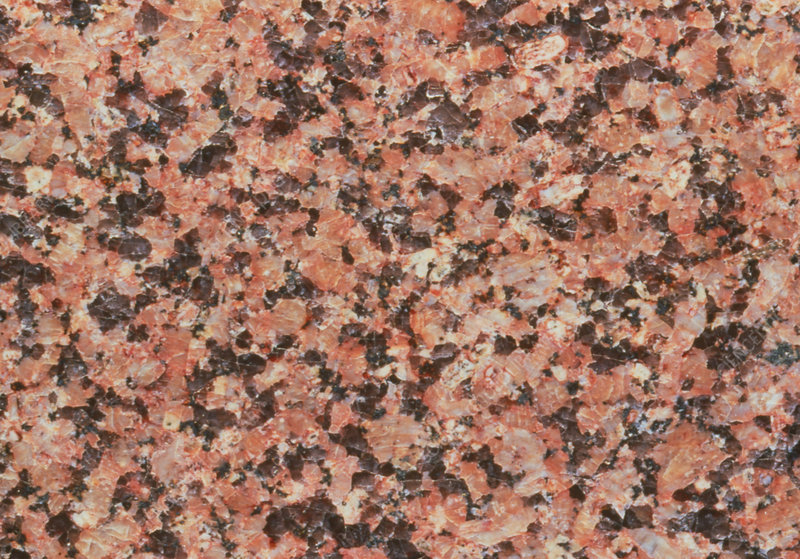
Granite is a significant stone in Scotland, known for its strength, durability, and distinctive appearance.
Scottish granite has been used for centuries in construction, monuments, and decorative elements, showcasing the country’s rich geological heritage.
Detailed Description and Properties
- Scottish granite is typically gray or pink in color, and its coarse, crystalline texture gives it a unique visual appeal.
- The stone is composed mainly of quartz, feldspar, and mica, contributing to its hardness and resistance to weathering and erosion.
- Granite’s durability and low water absorption make it an ideal material for both interior and exterior applications.
Historical Significance
- Granite has been quarried in Scotland for centuries, with many historic buildings and monuments featuring this iconic stone.
- The use of granite in construction has shaped the architectural landscape of many Scottish cities, such as Aberdeen, known as the “Granite City” due to its extensive use of stone.
Key Landmarks Featuring Granite
- The Rubislaw Quarry in Aberdeen, once the largest man-made hole in Europe, provided granite for many of the city’s buildings and monuments.
- The Marischal College in Aberdeen, the second-largest granite building in the world, showcases the grandeur and beauty of Scottish granite architecture.
- Other notable examples include Balmoral Castle, the Glasgow Necropolis, and Stirling Castle, all featuring impressive granite elements.
3. Slate (Wales)
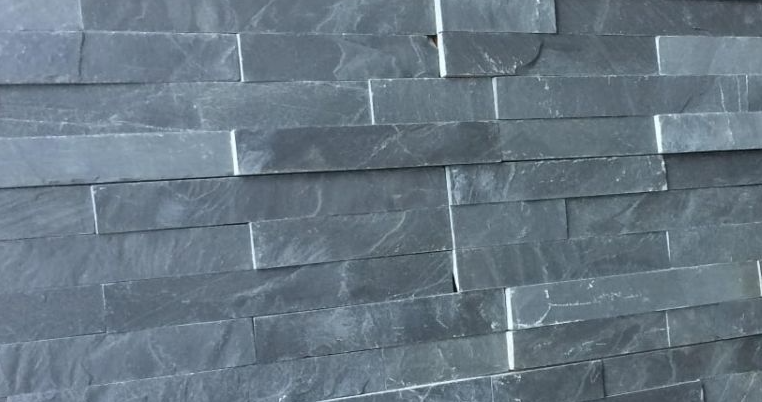
Slate is a quintessential Welsh stone. It has a long history of use in roofing, flooring, and decorative applications.
Welsh slate is prized for its durability, weather resistance, and distinctive appearance, making it a sought-after material worldwide.
Detailed Description and Properties
- Welsh slate is a fine-grained, metamorphic rock that is typically gray or blue-gray in color. It has a slight sheen and a smooth, even texture.
- The stone is known for its strength, low water absorption, and resistance to frost and chemical damage, making it an ideal material for indoor and outdoor use.
- Welsh slate is also prized for its ability to be split into thin, uniform sheets, which makes it perfect for roofing and cladding applications.
Historical Significance
- Slate has been quarried in Wales for centuries, and the industry has played a crucial role in the country’s economic and social history.
- The use of Welsh slate in construction has left an indelible mark on Wales’s architectural heritage, with many historic buildings and landmarks featuring this iconic material.
Notable Buildings and Structures
- The Penrhyn Slate Quarry in North Wales, once the world’s largest slate quarry, provided material for countless buildings and structures around the globe.
- The Welsh Slate Museum in Llanberis showcases the history and significance of the Welsh slate industry with exhibits and demonstrations of traditional slate-working techniques.
- Other notable examples include Caernarfon Castle, the National Library of Wales, and Portmeirion Village, all featuring stunning slate elements.
4. Basalt (Iceland)
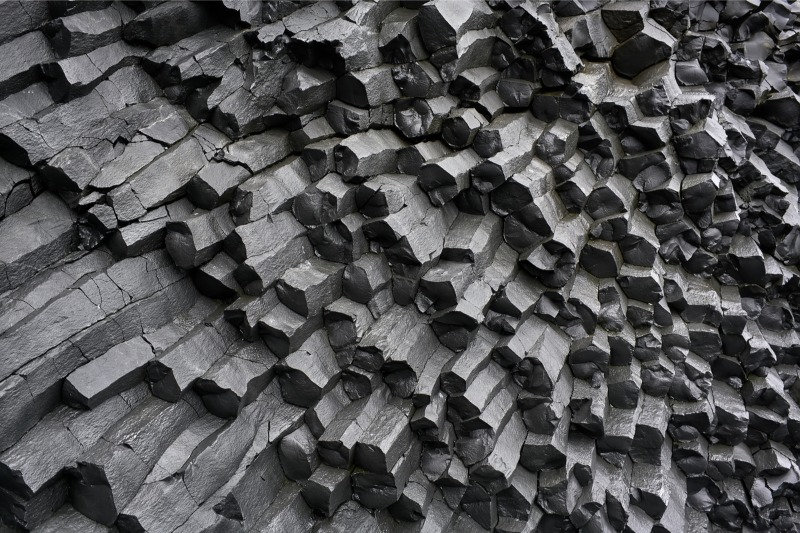
Basalt is a volcanic stone ubiquitous in Iceland, shaping the country’s unique and dramatic landscape.
Icelandic basalt is known for its dark color, distinctive texture, and stunning geological formations, such as hexagonal columns and vast lava fields.
Detailed Description and Properties
- Basalt is a fine-grained igneous rock that is typically black or dark gray in color and smooth or slightly rough in texture.
- The stone is composed mainly of plagioclase feldspar, pyroxene, and olivine, which give it its characteristic dark color and density.
- Basalt is known for its hardness, durability, and resistance to weathering and erosion, making it ideal for decorative and practical applications.
Geological Importance
- Basalt is Iceland’s most common rock type, formed by the rapid cooling of lava from the country’s many volcanoes.
- The presence of basalt in Iceland’s landscape is a testament to the country’s active geological history, with new lava fields and formations being created with each volcanic eruption.
Tourist Attractions and Landmarks
- The Reynisfjara Black Sand Beach in southern Iceland is a stunning example of the beauty and power of Icelandic basalt, with its towering hexagonal columns and dramatic cliff faces.
- Another iconic basalt formation is the Svartifoss Waterfall in Vatnajökull National Park. Its distinctive hexagonal columns frame the cascading water.
- Other notable examples include the Gerðuberg Cliffs, the Hljóðaklettar Echo Cliffs, and the Aldeyjarfoss Waterfall, all of which showcase Icelandic basalt’s incredible diversity and beauty.
Popular Stone from Asia
5. Jade (China)
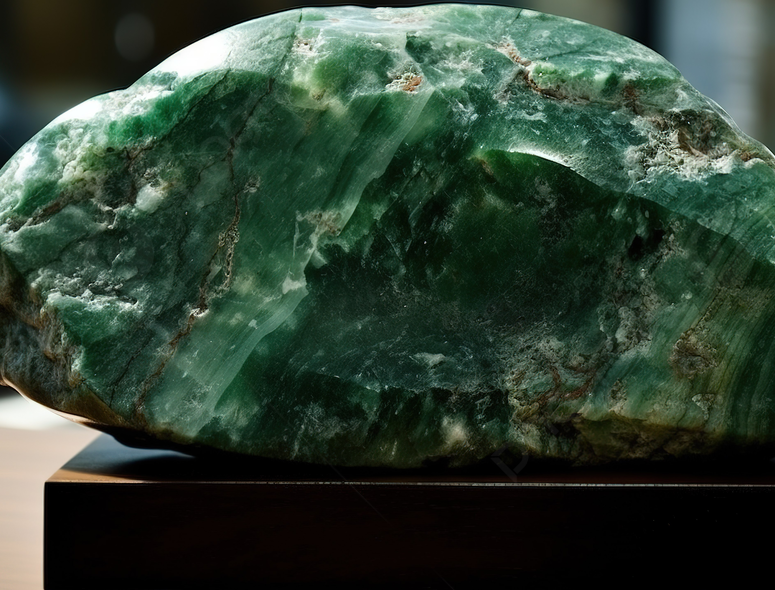
Jade is a revered stone in China, with a rich cultural and historical significance that dates back thousands of years.
Chinese jade is prized for its beauty, durability, and supposed mystical properties, making it a highly sought-after material for jewelry, decorative objects, and ceremonial items.
Detailed Description and Properties
- Jade is a general term for two different minerals: nephrite and jadeite. Both are known for their toughness, smooth texture, and vibrant green color.
- Chinese jade can range from pale green to deep emerald, with some varieties exhibiting white, lavender, or yellow hues.
- The stone is known for its hardness, which makes it difficult to carve, but it also contributes to its durability and longevity.
Cultural Significance
- Jade has played a central role in Chinese culture for centuries, with the stone associated with wealth, power, and spiritual significance.
- In ancient China, jade was used to create ritual objects, burial suits, and decorative items for the imperial court, with the stone being considered more valuable than gold or silver.
- Today, jade remains an important part of Chinese culture, with the stone used in jewelry, sculptures, and other decorative objects.
Historical Artifacts and Modern Uses
- The Jade Burial Suits of the Han Dynasty are among the most famous examples of ancient Chinese jade artifacts. The suits were crafted from thousands of small jade tiles sewn together with gold wire.
- The Jade Buddha Temple in Shanghai houses a massive jade Buddha statue, considered one of the most significant jade sculptures in the world.
- Other notable examples include Jade Dragon Snow Mountain in Yunnan Province, the Jade Market in Hong Kong, and the many jewelry and decorative objects still produced and cherished in China today.
6. Limestone (India)
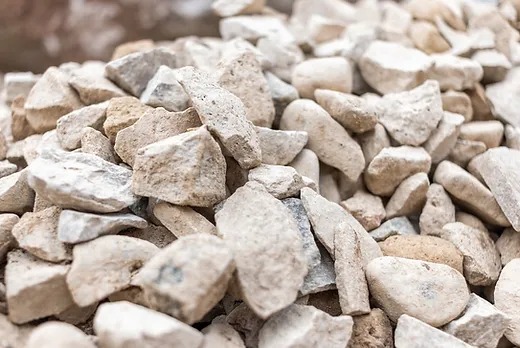
Limestone is a significant stone in India, with a long history of use in construction, sculpture, and decorative applications.
Indian limestone is known for its versatility, durability, and distinctive appearance. Many historic buildings and monuments feature this iconic material.
Detailed Description and Properties
- Limestone is a sedimentary rock composed mainly of calcium carbonate, which gives it a pale gray or cream color and a smooth, fine-grained texture.
- The stone is relatively soft and easy to carve, making it a popular material for sculptural and decorative elements.
- Limestone is also known for its durability and weather resistance, making it an ideal material for interior and exterior applications.
Historical and Contemporary Architecture
- Limestone has been used in Indian architecture for centuries, with many historic buildings and monuments featuring intricate limestone carvings and decorative elements.
- The use of limestone in contemporary Indian architecture has also been significant, with many modern buildings and public spaces incorporating this versatile material.
Famous Structures and Buildings
- The Taj Mahal in Agra is perhaps the most famous example of Indian limestone architecture, with its stunning white marble domes and intricate limestone carvings.
- The Victoria Memorial in Kolkata is another iconic limestone structure, with its grand domes, columns, and sculptures showcasing the beauty and versatility of the stone.
- Other notable examples include the Hawa Mahal in Jaipur, the Qutub Minar in Delhi, and the many historic limestone temples and palaces that dot the Indian landscape.
7. Onyx (Turkey)
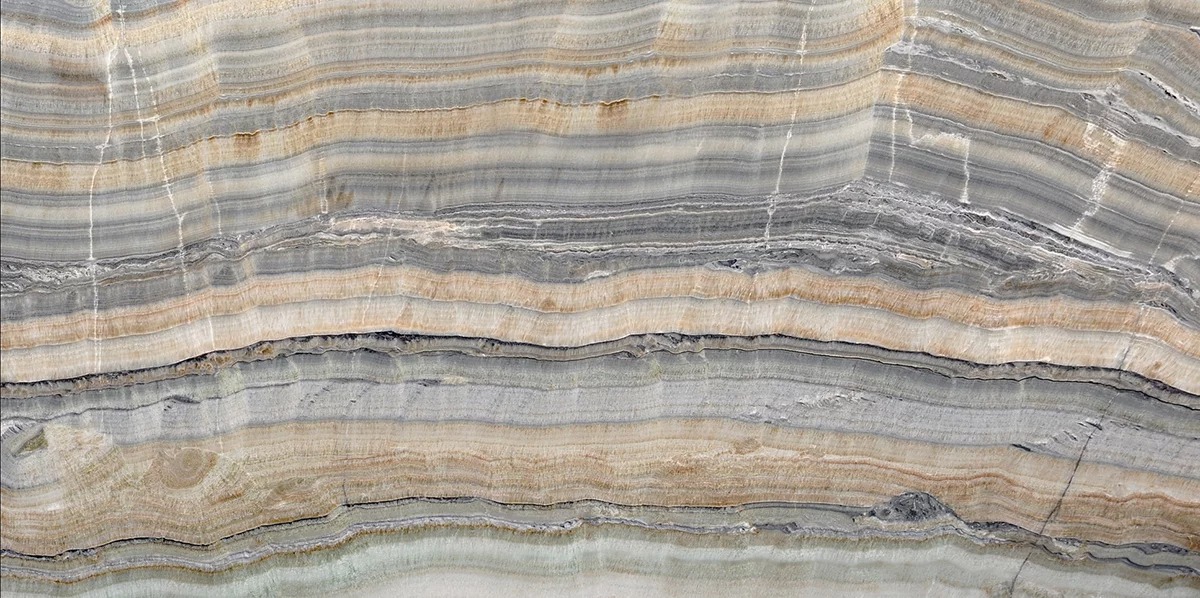
Onyx is a significant stone in Turkey. It has a long history of use in decorative objects, interior design, and architectural elements.
Turkish onyx is prized for its distinctive appearance, translucency, and intricate patterns and colors that make each piece unique.
Detailed Description and Properties
- Onyx is a type of banded chalcedony, a cryptocrystalline form of quartz known for its smooth texture and variegated colors.
- Turkish onyx can range from pale white to deep browns and reds, with many pieces exhibiting striking bands and patterns resembling landscapes or abstract art.
- The stone is known for its clarity, which allows light to pass through and creates a warm, inviting glow in interior spaces.
Uses in Interior Design and Decoration
- For centuries, onyx has been used in Turkish interior design and decoration, creating stunning light fixtures, wall panels, and decorative objects.
- Onyx’s translucency and color variations make it a popular material for backlit features such as bar counters, reception desks, and feature walls.
- Onyx is also used in high-end residential and commercial spaces, where it is incorporated into bathroom vanities, fireplace surrounds, and other decorative elements.
Examples of Notable Uses
- The Hagia Sophia in Istanbul features stunning onyx columns and decorative elements, showcasing the stone’s beauty and versatility in a historical context.
- The Antalya Archaeological Museum houses a collection of ancient onyx artifacts, including vases, bowls, and decorative objects from the Roman and Byzantine periods.
- Other notable examples include the many onyx light fixtures, wall panels, and decorative objects in high-end hotels, restaurants, and residential spaces throughout Turkey and beyond.
8. Soapstone (Pakistan)
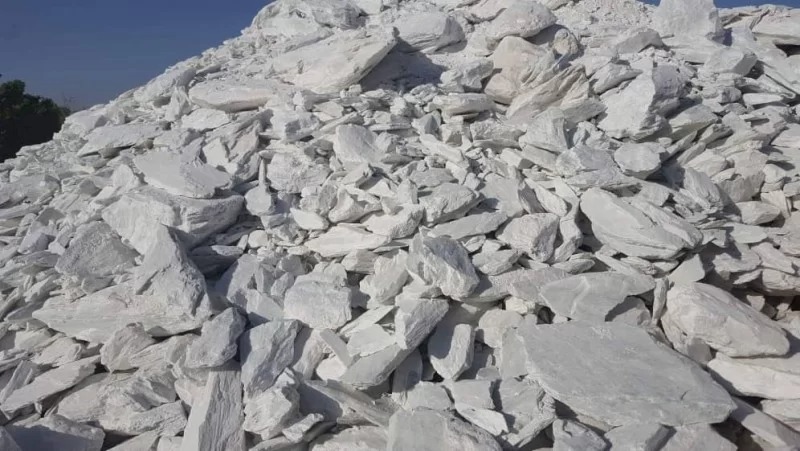
Soapstone is a significant stone in Pakistan, with a long history of use in traditional crafts, decorative objects, and architectural elements.
Pakistani soapstone is prized for its softness, ease of carving, and the unique colors and patterns that make each piece a work of art.
Detailed Description and Properties
- Soapstone is a metamorphic rock composed mainly of talc, which gives it a soft, soapy feel and a relatively low hardness compared to other stones.
- Pakistani soapstone can range from pale gray to deep greens and browns, with many pieces exhibiting unique veining and marbling patterns.
- The stone is known for its ease of carving, which makes it a popular material for sculptural and decorative objects and architectural elements such as fountains and fireplace surrounds.
Common Uses
- Soapstone has been used in Pakistani crafts for centuries. Skilled artisans use the stone to create intricate carvings, decorative objects, and functional items such as cooking pots and bowls.
- Soapstone is also used in architectural elements, with traditional Pakistani buildings such as mosques, palaces, and public spaces incorporating it.
- In recent years, Pakistani soapstone has gained popularity in the international market. The stone is used in high-end residential and commercial spaces worldwide.
Traditional and Modern Applications
- The ancient city of Taxila in Pakistan is home to many historic soapstone artifacts, including intricately carved statues, reliefs, and architectural elements that date back to the Gandharan period.
- The Hunza Valley in northern Pakistan is famous for its soapstone carvings. Local artisans create stunning decorative and functional objects using traditional techniques passed down through generations.
- Other notable examples include the many soapstone fountains, fireplace surrounds, and decorative objects found in high-end residential and commercial spaces worldwide, showcasing Pakistani soapstone’s beauty and versatility.
Popular Stone from Africa
9. Granite (Zimbabwe)

Granite is a significant stone in Zimbabwe, which is home to some of the oldest and most spectacular granite formations in the world.
Zimbabwean granite is known for its durability, unique colors and patterns, and its role in the country’s history and culture.
Detailed Description and Properties
- Granite is an igneous rock composed mainly of quartz, feldspar, and mica, which give it its characteristic speckled appearance and hard, durable texture.
- Zimbabwean granite can range in color from pale gray to deep reds and blacks, with many varieties exhibiting unique patterns and textures that make each piece a work of art.
- Stone is known for its hardness and weather resistance, making it ideal for both interior and exterior applications, including building construction, monuments, and decorative elements.
Major Mining Areas
- The Mutoko region in northeastern Zimbabwe is one of the country’s major granite mining areas. Stone is extracted from large quarries and exported around the world.
- The Masvingo province in southern Zimbabwe is also known for its granite reserves, with the stone being used in local construction and exported to neighboring countries.
- Granite mining plays a significant role in Zimbabwe’s economy. The stone is one of the country’s major exports and a source of employment for many people.
Famous Landmarks and Structures
- The Great Zimbabwe ruins, a UNESCO World Heritage Site, are perhaps the most famous example of Zimbabwean granite architecture. The massive stone walls and towers showcase the skill and ingenuity of the ancient Shona people.
- The Matobo Hills in southern Zimbabwe are another iconic granite formation. The area is home to thousands of ancient rock paintings and sacred sites.
- Other notable examples include the many granite sculptures and monuments throughout Zimbabwe, which showcase the country’s rich artistic heritage and the beauty of its natural stone.
10. Marble (Egypt)

Marble is a significant stone in Egypt, with a long history of use in ancient architecture, sculpture, and decorative elements.
Egyptian marble is known for its beauty, durability, and role in shaping the country’s cultural identity and legacy.
Detailed Description and Properties
- Marble is a metamorphic rock composed mainly of calcite or dolomite, which gives it a smooth, lustrous texture and a range of colors and patterns.
- Egyptian marble can range from pure white to shades of pink, yellow, and gray, with wide varieties exhibiting unique veining and marbling patterns.
- The stone is known for its hardness, weather resistance, and ability to take a high polish, making it an ideal material for interior and exterior applications, including sculpture, architecture, and decorative elements.
Historical Significance
- Marble has played a significant role in ancient Egyptian architecture and art, with the stone used to create stunning temples, palaces, and sculptures that have endured for thousands of years.
- Marble was used in ancient Egyptian art and architecture as a symbol of power, wealth, and cultural sophistication, and the stone was associated with royalty and the divine.
- Many of Egypt’s most famous landmarks and monuments, including the Pyramids of Giza and the temples of Luxor and Karnak, feature marble elements that showcase the skill and artistry of ancient Egyptian craftsmen.
Ancient Monuments and Current Uses
- The Pyramid of Khafre in Giza is one of the most famous examples of ancient Egyptian marble architecture. The smooth, polished limestone casing stones that once covered the pyramid showcase the stone’s beauty and durability.
- The Temple of Hatshepsut in Luxor is another iconic marble structure. The intricate carvings and reliefs on the temple walls and columns showcase the skill and artistry of ancient Egyptian sculptors.
- Today, Egyptian marble continues to be used in high-end residential and commercial spaces worldwide, with the stone being prized for its beauty, durability, and cultural significance.
11. Travertine (Morocco)

Travertine is a significant stone in Morocco. It has a long history of use in architecture and decorative elements.
Moroccan travertine is prized for its unique appearance, durability, and its role in shaping the country’s architectural heritage.
Detailed Description and Properties
- Travertine is a form of limestone deposited by mineral springs, especially hot springs. It is characterized by a porous structure and a range of colors, from white to cream, tan, and rust.
- The stone is known for its softness compared to other limestone types, making it easy to work with and carve into intricate designs.
- Travertine is also valued for its durability and weather resistance, making it suitable for interior and exterior applications.
Architectural Examples
- Travertine has been used in Moroccan architecture for centuries, with many historic buildings and landmarks featuring this distinctive material.
- The stone’s porous structure allows it to be used in various decorative applications, from intricate carvings and sculptures to large architectural elements such as columns and facades.
Notable Structures and Buildings
- The Hassan Tower in Rabat is a notable example of Moroccan travertine architecture, with its striking red travertine columns and intricate decorative elements.
- The Al Quaraouiyine Mosque in Fez, one of the oldest universities in the world, features beautiful travertine elements in its architecture and decoration.
- Other examples include the many historic riads and palaces in Marrakech, where travertine is used in courtyards, fountains, and decorative elements.
Popular Stone from America
12. Granite (USA)

Granite is a ubiquitous stone in the United States, which is home to numerous granite formations and a thriving granite industry.
American granite is known for its durability, versatility, and wide range of colors and patterns, making it a popular choice for interior and exterior applications.
Detailed Description and Properties
- Granite is an igneous rock composed mainly of quartz, feldspar, and mica, which give it its characteristic speckled appearance and hard, durable texture.
- American granite can range in color from pale whites and grays to deep reds, blues, and greens. Many varieties exhibit unique patterns and textures that reflect the stone’s natural formation process.
- The stone is known for its hardness, weather resistance, and ability to take a high polish, which makes it an ideal material for countertops, flooring, and other high-traffic areas.
Historical and Contemporary Uses
- Granite has been used in American architecture and construction for centuries, and the stone has been incorporated into many historic buildings, monuments, and public spaces.
- The use of granite in contemporary American architecture and design has also been significant. The stone is used in a wide range of applications, from kitchen countertops and bathroom vanities to outdoor pavers and landscaping elements.
- Granite is also a popular material for sculptural and decorative objects, and many American artists and craftsmen use it to create unique and beautiful works of art.
Prominent Structures and Monuments
- The Mount Rushmore National Memorial in South Dakota is one of the most famous examples of American granite sculpture. The massive carved faces of four U.S. presidents showcase the skill and artistry of the stone’s creators.
- The Bunker Hill Monument in Boston is another iconic granite structure. The 221-foot obelisk commemorates the famous Revolutionary War battle and serves as a symbol of American patriotism and resilience.
- Other notable examples include the many granite buildings, bridges, and public spaces throughout the United States, from the Brooklyn Bridge in New York City to the Yosemite Valley Chapel in California.
13. Obsidian (Mexico)

Obsidian is a significant stone in Mexico. It has a long history of use in ancient Mesoamerican cultures and a continued presence in modern Mexican art and culture.
Mexican obsidian is known for its glossy black color, sharp edges, and its role in shaping the country’s cultural identity and heritage.
Detailed Description and Properties
- Obsidian is a volcanic glass formed by the rapid cooling of lava. This process gives it a smooth, shiny surface and a uniform black color.
- Mexican obsidian is known for its exceptional sharpness, with its edges often sharper than surgical steel.
- Obsidian’s hardness and durability made it ideal for ancient Mesoamerican tools, weapons, and ceremonial objects. It was used to create everything from arrowheads and knives to mirrors and ritual masks.
Historical Artifacts
- Obsidian played a significant role in ancient Mesoamerican cultures, with the stone used in a wide range of tools, weapons, and ceremonial objects.
- The Aztecs and Maya, in particular, were known for their skilled use of obsidian. The stone was used to create intricate ceremonial knives, figurines, and other objects that played a central role in religious and political life.
- Many of these ancient obsidian artifacts can be found in museums and archaeological sites throughout Mexico, providing a fascinating glimpse into the country’s rich cultural heritage.
Modern Uses
- While obsidian is no longer used for tools and weapons in modern Mexico, the stone plays a significant role in Mexican art and culture.
- Many contemporary Mexican artists and craftsmen use obsidian to create unique and beautiful sculptures, jewelry, and decorative objects that showcase the stone’s natural beauty and cultural significance.
- Obsidian is also a popular material for tourist souvenirs and gifts, with many shops and markets throughout Mexico selling obsidian figurines, jewelry, and other items to visitors worldwide.
14. Travertine (Peru)

Travertine is a significant stone in Peru. It has a long history of use in ancient Incan architecture and a continued presence in modern Peruvian design and construction.
Peruvian travertine is known for its warm, earthy colors, unique textures, and its role in shaping the country’s architectural heritage and identity.
Detailed Description and Properties
- Travertine is a type of limestone formed by the precipitation of calcium carbonate from mineral springs, which gives it a porous, layered texture and a range of warm, earthy colors.
- Peruvian travertine can range in color from pale ivory to deep golds and reds, with many varieties exhibiting unique patterns and textures that reflect the stone’s natural formation process.
- The stone is known for its durability, weather resistance, and ability to evoke a sense of warmth and elegance in interior and exterior spaces.
Historical Significance
- Travertine played a significant role in ancient Incan architecture, and the stone was used to construct many of the civilization’s most famous buildings and structures.
- The use of travertine in Incan architecture symbolized power, wealth, and cultural sophistication. The stone was also associated with royalty and religious significance.
- Many of Peru’s most famous archaeological sites, including Machu Picchu and the ruins of Ollantaytambo, feature travertine elements that showcase the skill and artistry of ancient Incan stonemasons.
Modern Architecture
- While travertine is no longer used on the same scale as in ancient times, the stone plays a significant role in modern Peruvian architecture and design.
- Many contemporary Peruvian architects and designers use travertine in high-end residential and commercial projects. The stone is prized for its beauty, durability, and cultural significance.
- Travertine is often combined with other traditional Peruvian building materials, such as adobe and wood, to create a harmonious and distinctively Peruvian aesthetic.
Popular Stones from Oceania
15. Opal (Australia)

Opal is a highly prized gemstone closely associated with Australia, the world’s leading producer of high-quality opals.
Australian opals are known for their stunning play of color, unique patterns, and the sense of beauty and mystery associated with the stone.
Detailed Description and Properties
- Opal is a hydrated amorphous form of silica characterized by its unique play of color caused by the diffraction of light through the stone’s microscopic spheres.
- Australian opals come in a wide range of colors and patterns, with the most valuable stones exhibiting a bright, vivid play of color that spans the entire visible spectrum.
- Opals’ delicate structure and relatively low hardness make them more susceptible to damage than other gemstones, and they require special care and protection to maintain their beauty and value.
Cultural Significance
- Opals have played a significant role in Australian culture and folklore for thousands of years, with the stone being prized by indigenous Australians for its beauty and spiritual significance.
- In modern times, opals have become a symbol of Australia’s natural beauty and cultural heritage, with the stone being featured prominently in Australian art, literature, and popular culture.
- The town of Coober Pedy in South Australia, known as the “opal capital of the world,” has become a major tourist attraction, with visitors from around the world coming to see the town’s unique underground dwellings and opal mines.
Economic Impact
- The opal mining industry significantly contributes to the Australian economy, producing around 90% of the world’s opals by value.
- The industry is centered around several major opal fields, including Lightning Ridge in New South Wales, Coober Pedy in South Australia, and Mintabie in the Northern Territory.
- The value of Australian opal production has fluctuated over the years due to changing market conditions and supply and demand factors. Still, the stone remains a highly prized and sought-after gemstone worldwide.
Unique and Exotic Stones
16. Blue John (England)
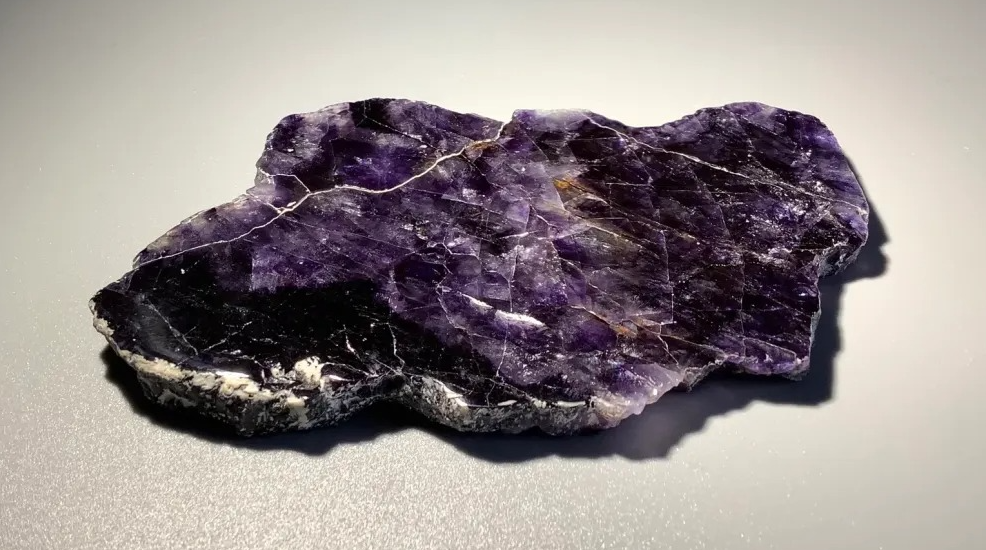
Blue John is a rare and highly prized fluorite found only in the Blue John Cavern in Derbyshire, England.
English Blue John is known for its unique blue and purple banded patterns. Collectors and decorative artists prize the stone for its beauty and rarity.
Detailed Description and Properties
- Blue John is a type of fluorite characterized by its distinct blue and purple banding, which is caused by trace minerals and variations in the stone’s crystal structure.
- The stone’s color can range from pale blue to deep purple, with some pieces exhibiting a striking zigzag or “trapiche” pattern that collectors highly prize.
- Blue John is a relatively soft stone, with a hardness of 4 on the Mohs scale. This makes it unsuitable for use in jewelry and requires careful handling and protection.
Historical Uses
- Blue John has been mined and used for decorative purposes in England since the 18th century. The stone is fashioned into vases, bowls, and other ornamental objects.
- During the Victorian era, Blue John became particularly popular among the British aristocracy, with many wealthy families commissioning Blue John pieces for their homes and collections.
- Today, antique Blue John objects are highly sought after by collectors and museums, with pieces often selling for significant sums at auction.
Modern Uses
- Due to the limited supply of Blue John and the mining challenges, the stone is no longer widely used for large-scale decorative objects.
- However, some modern artisans and designers still use Blue John to create smaller decorative pieces, such as figurines, boxes, and inlay work.
- Blue John is also popular among mineral collectors. Due to their rarity and unique beauty, high-quality specimens command premium prices.
17. Petrified Wood (USA)
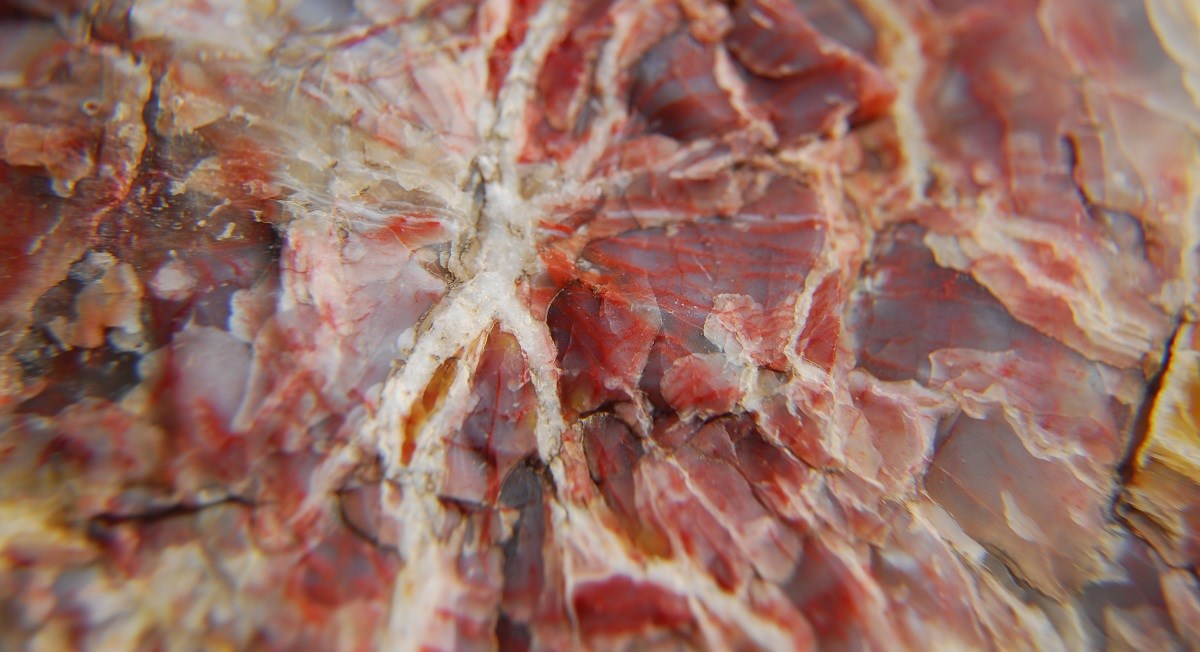
Petrified wood is a type of fossilized wood found in several locations across the United States, with the most famous deposits located in Arizona’s Petrified Forest National Park.
American petrified wood is known for its stunning colors and patterns, which are caused by replacing the original wood structure with minerals over millions of years.
Detailed Description and Properties
- Petrified wood is formed when fallen trees are buried by sediment and subjected to high-pressure and mineral-rich groundwater over millions of years.
- During this process, the original wood structure is slowly replaced by minerals such as quartz, calcite, and iron oxides, which give petrified wood its unique colors and patterns.
- Depending on the specific minerals present in the wood, petrified wood can exhibit a wide range of colors, from deep reds and oranges to vibrant blues and greens.
Formation Process
- The formation of petrified wood is a slow and complex process that requires specific geological conditions and a significant amount of time.
- For wood to become petrified, it must be buried quickly by sediment and protected from decay by bacteria and fungi.
- As groundwater percolates through the buried wood, it deposits minerals in the wood’s cells and tissues, slowly replacing the organic material with inorganic minerals.
Uses in Decoration
- Petrified wood is a popular material for decorative objects and jewelry. Its unique colors and patterns make it a striking and eye-catching choice.
- Petrified wood can be cut and polished into various shapes and sizes, from small cabochons and beads to larger sculptures and furniture pieces.
- In addition to its decorative uses, petrified wood is popular among collectors and enthusiasts, with high-quality specimens commanding significant prices on the market.
18. Rhodochrosite (Argentina)
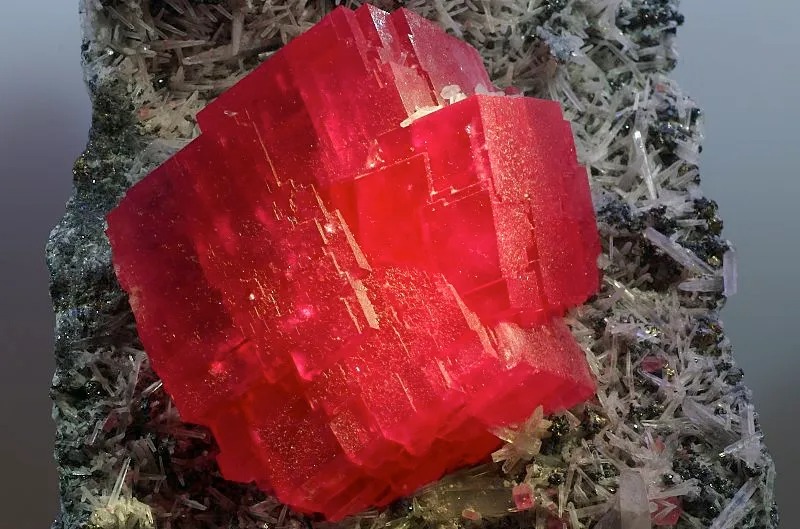
Rhodochrosite is a manganese carbonate mineral found in several locations worldwide, with some of the most significant deposits in Argentina.
Argentine rhodochrosite is known for its stunning pink and red color and unique banded patterns, making it a highly prized material for decorative objects and jewelry.
Detailed Description and Properties
- Rhodochrosite is a secondary mineral that forms in the oxidation zones of manganese deposits, often in association with other manganese minerals such as pyrolusite and manganite.
- The mineral is characterized by its pink-to-red color and distinctive banded patterns, which are caused by variations in its crystal structure and trace elements.
- Rhodochrosite is a relatively soft mineral, with a hardness of 3.5-4 on the Mohs scale, which means it requires careful handling and protection to avoid scratches and damage.
Uses in Art
- Rhodochrosite has been used for decorative and artistic purposes for centuries. The mineral’s stunning color and patterns make it a popular choice for sculptures, carvings, and other decorative objects.
- In recent years, rhodochrosite has become particularly popular among lapidary artists, who use the mineral to create cabochons, beads, and other jewelry components.
- Rhodochrosite is also used in inlay work and as a decorative accent in high-end furniture and interior design.
Cultural Significance
- Rhodochrosite has played a significant role in Argentine culture and folklore. The mineral is associated with love, passion, and emotional healing.
- In some Argentine communities, rhodochrosite is believed to have powerful spiritual and metaphysical properties. The mineral is used in meditation, crystal healing, and other esoteric practices.
- Rhodochrosite has also become a popular tourist souvenir in Argentina, with many shops and markets selling a wide range of rhodochrosite jewelry and decorative objects.
Conclusion
From breathtaking marble in Italy to rare larimar in the Dominican Republic, our journey through 18 unique stones worldwide has showcased Earth’s geological treasures’ incredible diversity and beauty.
Each stone tells a story of its formation, cultural significance, and the artisans who have shaped it into works of art.
As we marvel at these wonders, it’s clear that our planet’s geological heritage is a precious resource to be cherished and preserved for future generations.
So, the next time you hold a piece of jewelry or gaze upon a stone monument, take a moment to appreciate the remarkable history and craftsmanship behind it.
Which of these stones captured your imagination? Share your thoughts in the comments below, and let’s continue celebrating the amazing world of stones together.






















































